Social Care Services, Scotland, 2013
Information on Home Care Services, Self-Directed Support (Direct Payments), Community Alarms and Telecare, Meals services and Housing Support Services.
This document is part of a collection
4. Working Adults - Clients aged 18 to 64 year old
4.1 Home Care for adults aged 18 to 64
The number of clients aged between 18 and 64 per 1,000 population has risen in the last year as shown in Figure 24.
Figure 24: Rates per population of Clients aged 18 to 64 receiving Home Care Services, 2000 to 2013
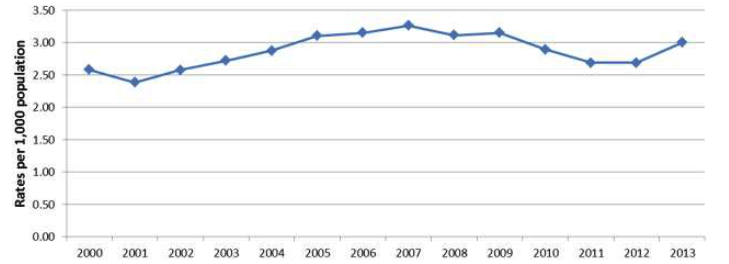
Source: Social Care Survey 2013, Home Care Census 2000-2012
General Register Office for Scotland mid-year populations up to 2012 (latest available).
Figure 13 shows that the majority of Home Care clients aged 18 to 64 and over receive care for less than 15 hours per week, and that the number of clients receiving more than 20 hours of care per week is relatively small.
Figure 25: Home Care clients aged 18 to 64 by level of service
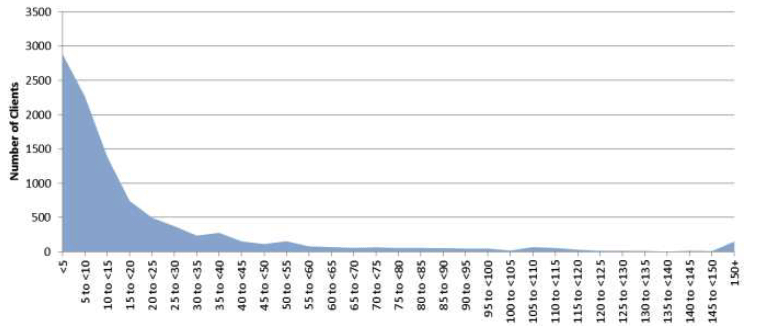
Source: Social Care Survey 2013
Table 3 shows that the 33% of Home Care clients aged 18 to 64 receive their care solely from Local Authorities, compared with 39% receiving care solely from the private sector and 22% solely from the voluntary sector.
Table 3: Number of Home Care clients aged 18 to 64, and hours provided, by Service Provider, 2013
| Provider of Service | Number of clients | % | Clients Hours | % | Average hours per client |
|---|---|---|---|---|---|
| Local Authority only | 3,267 | 33% | 35,298 | 17% | 10.8 |
| Private sector only | 3,936 | 39% | 87,406 | 43% | 22.2 |
| Voluntary sector only | 2,220 | 22% | 68,427 | 33% | 30.8 |
| LA plus private | 339 | 3% | 7,074 | 3% | 20.9 |
| LA plus voluntary | 109 | 1% | 2,343 | 1% | 21.5 |
| All other combinations of 2+ providers | 128 | 1% | 3,971 | 2% | 31.0 |
| TOTAL | 10,039 | 100% | 204,519 | 100% | 20.4 |
Source: Social Care Survey 2013
Figure 26 shows that the majority of Home Care clients aged 18 to 64 have either a learning disability or a physical disability.
Figure 26: Home Care Clients aged 18 to 64 by client group
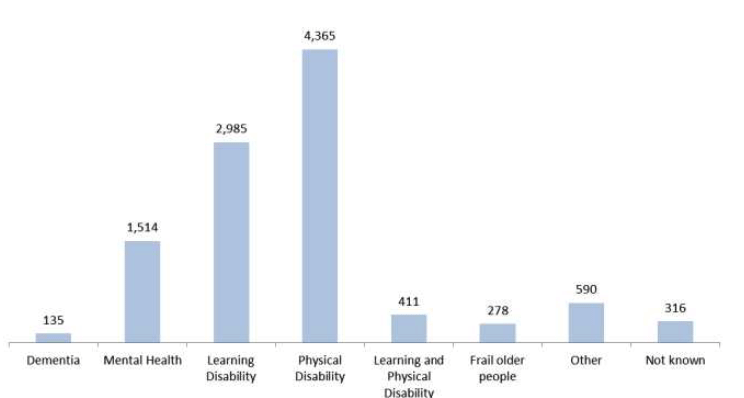
Source: Social Care Survey 2013
Note: "Dementia" is under recorded in the social care management information system.
Figure 27 shows that of the clients aged 18 to 64 receiving Home Care in 2013 whose living arrangements are known, 45% live alone. This compares to 65% for those aged 65 and over (See Figure 15).
Figure 27: Living arrangement of clients aged 18 to 64 receiving Home Care services, 2013
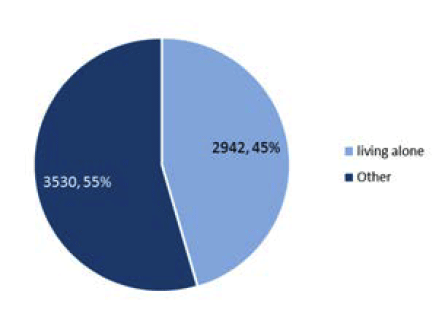
Social Care Survey 2013
Note: 3,567 clients had unknown living arrangements
4.2 Community Alarm / Telecare Services for clients aged 18 to 64
Information is collected on clients who receive services other than Home Care in their own home. These include; Community Alarms and other Telecare services. This information was collected for the first time in 2010, however a number of Local Authorities in 2010 were not able to provide information on all the clients in receipt of a Community Alarm and/or another Telecare Service. Since 2011, the completeness of this data has improved considerably. Trends over time therefore are presented from 2011 onwards. The Background Information provided in this report contains definitions of Community Alarm and 'other Telecare' services.
As at the census week in March 2013, there were 16,190 people aged 18 to 64 receiving a Community Alarm and/or another Telecare Service. Of these, 71% had only a Community Alarm.
Figure 28: Distribution of clients aged 18 to 64 receiving Community Alarm and/or another Telecare service, by client group, 2013
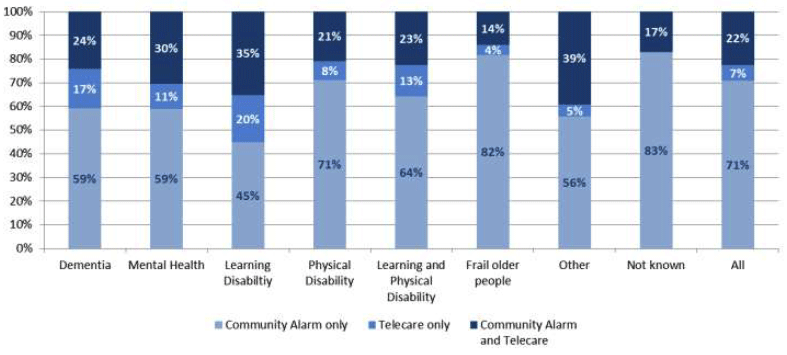
Source: Social Care Survey 2013
Note: "Other" includes addictions, palliative care and carers
Note: "Dementia" is under recorded in the social care management information system.
Figure 29 shows the number of clients receiving a Community Alarm and/or Telecare between 2010 and 2013. After an initial drop between 2010 and 2011, the figure has increased each year.
Figure 29: Clients aged 18 to 64 who are receiving Community Alarm and/or other Telecare services, 2010 to 2013
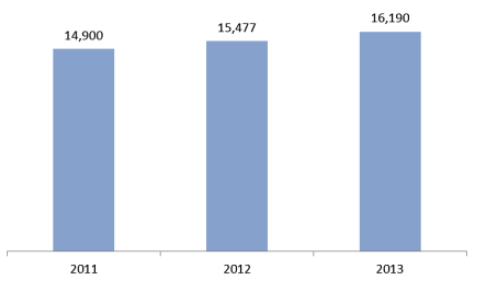
Source: Social Care Survey 2013, Home Care Census 2010-2012
Note: 2011-2012 figures include those aged 0 to 18
4.3 Meals Services for clients aged 18 to 64
The following table and chart contain information about Meals Services which clients can receive in their own home. Figure 30 shows that the majority of meals provided to clients aged 18 to 64 are frozen meals. 14 Local Authorities provided only hot meals, 11 provided only frozen means, 4 provided both. 3 authorities did not provide meals data.
Figure 30: Clients aged 18 to 64 who are receiving Hot or Frozen Meals Services, 2010 to 2013
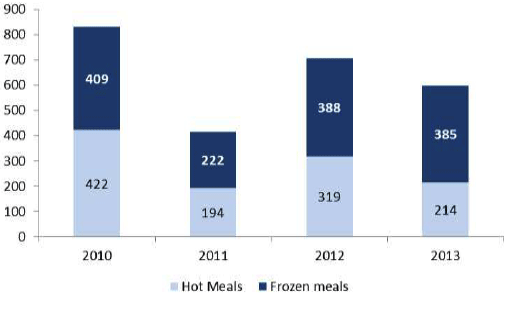
Source: Social Care Survey 2013, Home Care Census 2010-2012
Note: 2010-2012 include people aged 0 to 18
Note: One client received both frozen and hot meals in 2013
4.4 Housing Support for clients aged 18 to 64
In 2013 over 7,500 clients aged 18 to 64 received Housing Support. Figure 31 shows that the majority of these (55%) were female.
Figure 31: Clients aged 18 to 64 who receive Housing Support, 2013
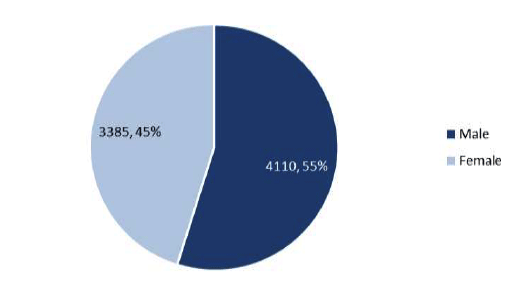
Source: Social Care Survey 2013
Figure 32 shows that learning disability is the primary reason for clients aged 18 to 64 receiving Housing Support, accounting for over 2,500 cases.
Figure 32: Clients aged 18 to 64 who receive Housing Support by client group, 2013
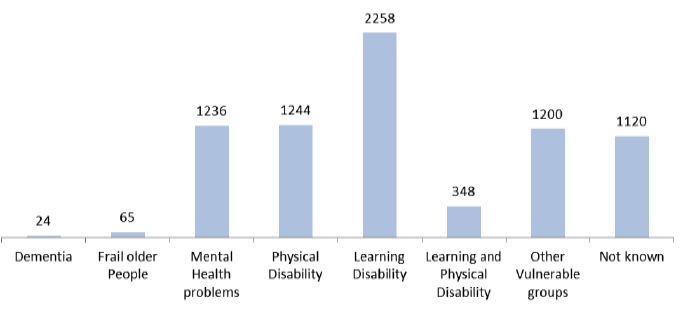
Source: Social Care Survey 2013
Note: "Dementia" is under recorded in the social care management information system.
4.5 Direct Payments for clients aged 18 to 64
In the year ending 31 March 2013, 2,879 people aged 18 to 64 received Direct Payments. The total expenditure by local authorities on Direct Payments was £45.4 million. The number of clients aged between 18 and 64 receiving Direct Payments has increased steadily since 2001 (see Figure 33).
Figure 33: Number of people aged 18 to 64 who received direct payments between 2001 and 2013
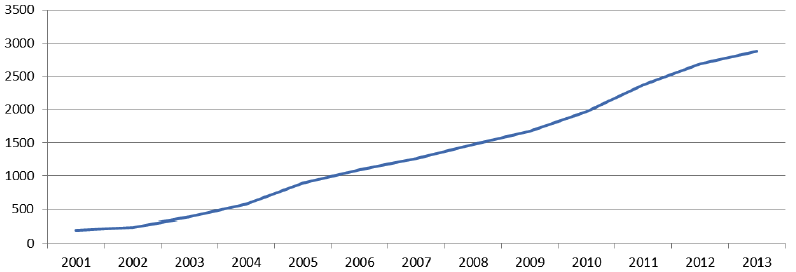
Source: Social Care Survey 2013, Self-directed Support (Direct Payments) Survey 2001-2012
Table 4 and Figure 34 show the breakdown of clients aged 18 to 64 receiving direct payments for each client group. While physical disability is the primary reason for clients in this age group receiving Direct Payments, the average (mean) amount spent per client is highest for those with Dementia.
Table 4: Number of clients aged 18 to 64 and value of Direct Payments, by client group, 2013
| Client Group | Number of clients | Expenditure (£ thousands) | Average £ per client |
|---|---|---|---|
| Dementia | 54 | £1,054 | £19,521 |
| Mental Health Problems | 222 | £4,247 | £19,129 |
| Learning Disability | 884 | £14,052 | £15,896 |
| Learning Disability and Physical Disability | 182 | £2,672 | £14,680 |
| Physical disability | 1,312 | £20,325 | £15,492 |
| Frail Older people | 25 | £275 | £10,998 |
| Other vulnerable groups | 144 | £1,973 | £13,704 |
| Not known | 56 | £831 | £14,831 |
| Total | 2,879 | £45,429 | £15,779 |
Social Care Survey 2013
Note: One client had an unknown client group
Note: "Dementia" is under recorded in the social care management information system.
Figure 34: Average value of Direct Payments per client, by client group, for clients aged 18 to 64, 2013
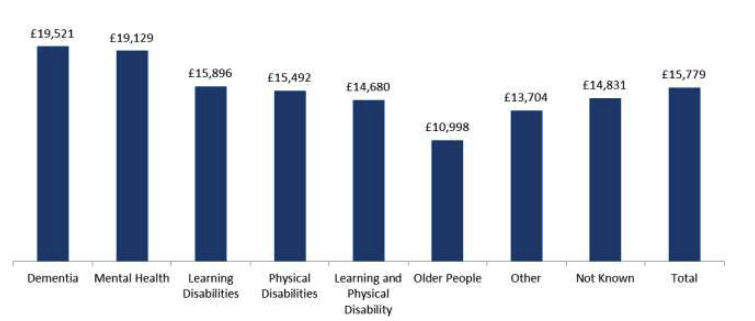
Source: Social Care Survey 2013
Note: "Dementia" is under recorded in the social care management information system.
Contact
Email: Steven Gillespie
There is a problem
Thanks for your feedback